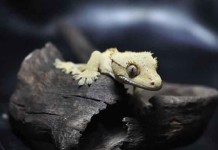Crested gecko breeding is relatively easy. It requires a minimum of preparation but should be done carefully to ensure the health of the geckos and their hatchlings. By following a few simple procedures to ensure a successful breeding, you will be rewarded with healthy crested geckos.
Sexing
Determining the sex of the crested gecko can generally be accomplished when the gecko is approximately six months old. The male develops an easily identifiable hemipenal bulge right below the vent. Conversely, the female will not have a bulge.
Crested gecko sexing can be attempted earlier in their development by closely examining them with the use of a jeweler’s loupe. The presence of pre-anal pores specifies a male. The pores run horizontally between the hind legs. They appear to have a dented center and a shinier surface. The female will not have pre-anal pores.
Breeding
 Before attempting to breed the crested gecko, make sure that they are at least 35 grams. This weight is generally reached between 12-14 months. This weight does include the tail, so if the crested gecko is tailless, subtract 3-5 grams. Also make sure both, especially the female, are well-nourished by feeding them gut-loaded crickets, the Repashy Crested Gecko Diet and supplements of calcium and Vitamin D3.
Before attempting to breed the crested gecko, make sure that they are at least 35 grams. This weight is generally reached between 12-14 months. This weight does include the tail, so if the crested gecko is tailless, subtract 3-5 grams. Also make sure both, especially the female, are well-nourished by feeding them gut-loaded crickets, the Repashy Crested Gecko Diet and supplements of calcium and Vitamin D3.
During mating, the male crested gecko mounts the female, grasping her neck with his mouth. The geckos will make noises, including clicking and squeaking sounds. The nature of mating looks rough but it is perfectly normal. When the male dismounts, he will begin to lick his hemipenis until it returns to its normal position.
The first clutch of two eggs will be produced by the female within 30-35 days after mating. The female retains sperm, using it to fertilize eggs, up to four months. Approximately every 30 days the female crested gecko will produce two eggs.
The female crested gecko will bury her eggs in the container with moist substrate that you provide. Check the container daily for eggs and transfer them carefully to an incubator. You can either purchase a ready-made incubator or make your own. The eggs can be kept in a sealed container lined with moist substrate. The temperature should remain between 72°F-79°F.
Crested gecko eggs should not be turned for the embryo can be detached from the shell and this will drown them. You may wish to mark the egg in case they get moved during incubation. Incubation times vary and can run anywhere from 65 days up to 120.
Crested gecko breeding takes little preparation and lots of patience. Simply allow the process to run its course and you will be rewarded with new hatchlings.
Preparing The Geckos for Breeding
Preparing them for breeding is relatively easy and can be accomplished with just a few important steps.











